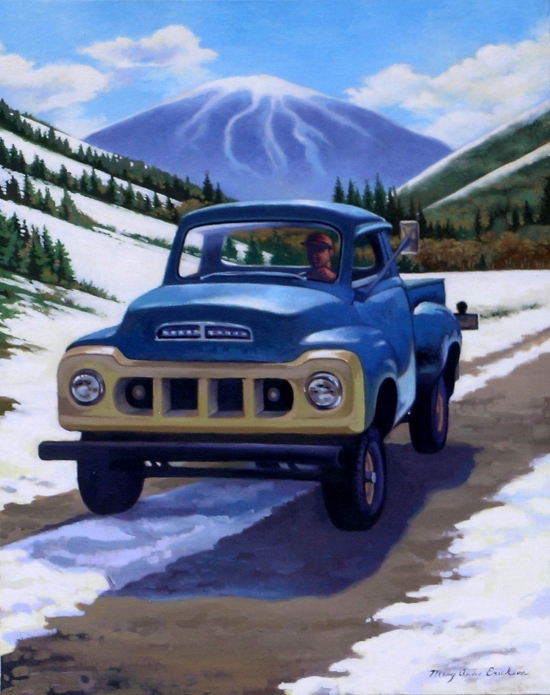Wherever I go on my travels, I’m always on the lookout for great remnants from our roadside past to paint – be they great old signs, businesses that have survived or been revitalized, and of course the wonder of old cars and trucks! A few years back, while visiting Richard’s family in Sun Valley, Idaho, I had the pleasure of meeting Chris Key and his 1960 Studebaker. Now that’s when cars and trucks had real personalities! I was smitten by the worn-out blue, the friendly nose and grill work – and considering the climate and road conditions in the mountains, its excellent condition.
So where would be the best place to take a few snapshots for a painting? He recommended an old road that’s only passable in the summertime as a quiet spot with a great view of Mt. Baldy in the background. We headed out on a sunny, brisk Idaho day and the rest is history. I painted this in oils and it’s been part of the collection at Stephano’s Fine Art Gallery in Little Rock, Arkansas for the last few years.
I wrote down a few important details about Chris’ prize: this was a very special four-wheel drive, line-built vehicle. They only made 66 of these small half-ton trucks in 1960 and Chris owns #33. He said they were sold to the Navy on a military contract.
I went online to see what I could dig up about the history of this model and had to search long and hard to find much of anything. Now I’m beginning to think that what Chris has here is truly legendary! These few paragraphs are all I could find of note and this is definitely the same model (from Wikipedia):
Transtar was the model name given to the line of trucks produced by the Studebaker Corporation of South Bend, Indiana, from 1956-1958 and 1960-1963. The Transtar name was first introduced for the 1956 (2E series) model year in 1/2-ton, 3/4-ton, 1-ton, 2-ton, and 2-ton heavy-duty capacities. The three smaller models were available with factory-built pick-up bodies. The basic styling of these trucks dated back to the 1949 models, though they had received some styling and engineering changes in 1954 and 55. The Transtar name continued to be used on most of the 1957-58 3E series trucks, though a stripped-down Studebaker Scotsman model without the Transtar name was introduced in the 1958 model year. The 57-58 Transtars received an aggressive new fiberglass grille that attempted (largely successfully) to make Studebaker’s outdated cab design look fresh and new. For now-unknown reasons, the Transtar name was dropped for the 1959 4E series Studebaker trucks and changed to Deluxe.
For 1960, Studebaker introduced a new line of 1/2-ton and 3/4-ton trucks under the name Studebaker Champ. The Champs used front-end and cab sheet metal from the 1959-60 Lark passenger cars, mated to their existing light-duty truck chassis and drive trains. The Champs were created in response to the Ford Ranchero (introduced in 1957) and Chevrolet El Camino (introduced in 1959), which used passenger car styling and features in a light-duty pickup truck. The Transtar name reappeared on Studebaker’s medium and heavy-duty trucks (1- and 2-ton) for 1960, and continued to be used on these trucks up through its 1964 models. Studebaker suspended production of all of its truck models when it closed its United States factory in December 1963.






